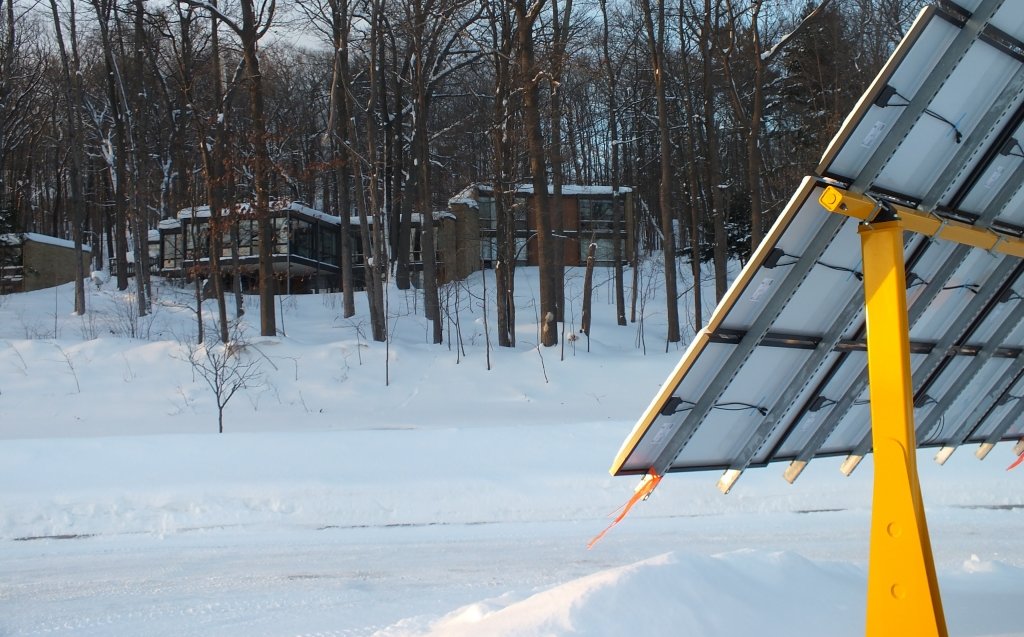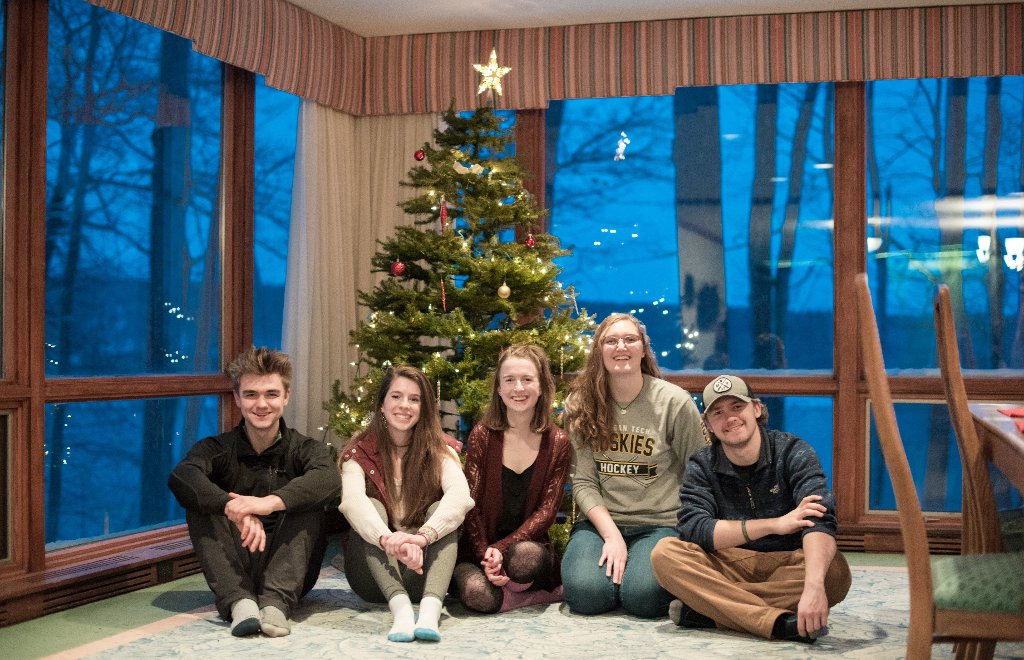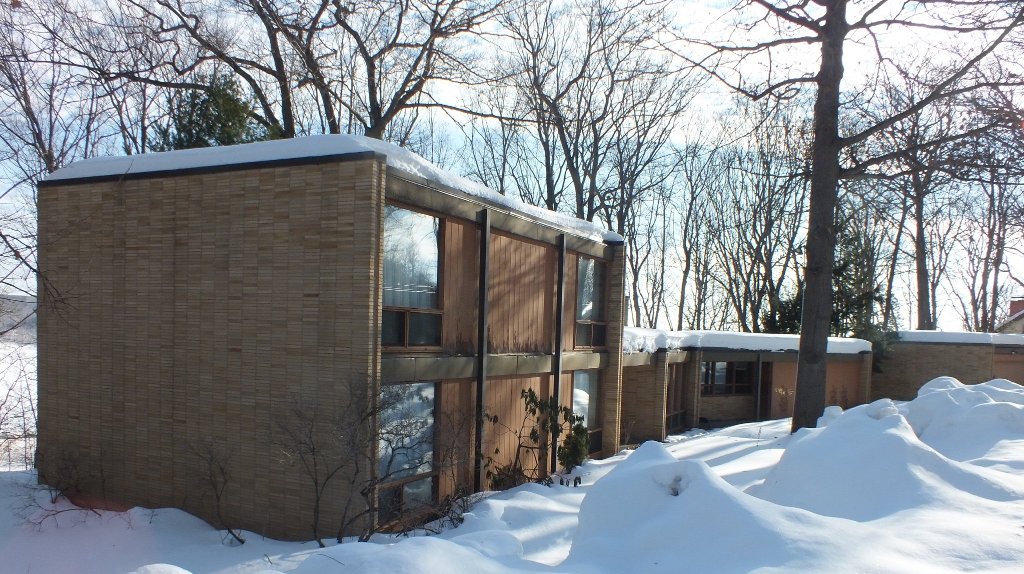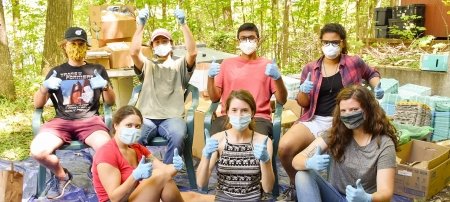A solar bank powers up at the former University presidential residence—with help from regional businesses and Husky alumni.
Michigan Technological University's Sustainability Demonstration House (SDH) will soon get energy from the sun. Generous donations from several sources supplied an 8,000-watt state-of-the-art solar-battery installation to provide renewable energy to the 5,000-square-foot, six-bedroom, six-bathroom, Kettle-Gundlach home on Woodland Drive. Built in 1953, transferred to Tech in 1992, it was home to two presidents, Dale Stein and Curt Tompkins.
“Since the house is on a wooded lot and the roof is flat, it's not an ideal site for solar,” says Jay Meldrum, faculty advisor for Alternative Energy Enterprise (AEE) and sustainability house project leader.
Across the street it's a different story. Michigan Tech parking lot 10E off US Highway 41 is an ideal site, with little obstruction from nearby trees.
"All that was needed is a wire under the highway,” notes Meldrum. "Baraga Telephone Company was quick to see the value and donate the equipment, manpower, and conduit to make this happen."
In July, the company, located in Baraga, Michigan, about 26 miles south of Tech, ran a 360-foot conduit from parking Lot 10E to the back door of the house. Next, a foundation was excavated and poured to hold the panel racks built and donated by Massie Manufacturing, also headquartered in Baraga. Massie has constructed several panel racks for the Photovoltaic Research Center installation at Michigan Tech's Keweenaw Research Center. Two small racks, rather than one wide rack, were designed by KRC to minimize the parking lot footprint for parking and snow removal. No car parking spaces were eliminated compared to last year.
Family Duo and Local Company Team Up
Another company with both local and Michigan Tech connections came through with solar panel modules. CertainTeed Solar, of Valley Forge, Pennsylvania, a division of CertainTeed Corporation in nearby L’Anse, donated 32 260-watt panels, with black frame and backsheet. CertainTeed Solar Director Mark Stancroff, who earned his BS in mechanical engineering from Michigan Tech in 1986, heard about the project from his nephew Nathan, a mechanical engineering undergraduate who is working on the project, including design and construction of the base and rails.
"CertainTeed is excited to be a part of the Sustainable Demonstration House—our mission is to be North America’s leader in sustainable habitat. Michigan Tech's research will provide valuable information to help us meet that goal," Stancroff says.
"Here's a company 113 years old, backing solar," says Meldrum. "There are many solar companies that open and close in a very short time frame."
"I’m looking forward to seeing a nice array of all black CertainTeed mono-panels the next time I get to Houghton!"
AC/DC: More Than a Rock Band
The solar panel modules create 400 volts DC (direct current) at 23 amps. DC power needs to be inverted to AC (alternating current) to use with the home's electrical system. The electronics required to do were made possible through a cash donation from Westwood Professional Services of Madison, Wisconsin. AEE student and house tenant Rose Turner, an environmental engineering major, worked there as an intern this past summer. "When she told her supervisors about the project, they were eager to help and promote their company name on campus," says Meldrum. John Soyring, a 1976 graduate and 2004 Department of Electrical Engineering Academy inductee, matched the donation to complete the purchase of the inverter and battery charger.
Turner, and four other student tenants, moved in just in time for fall semester 2017. Obligations in addition to rent include working on the home 20 hours per month, and hosting open houses each semester.

Putting the Pieces Together
Peninsula Solar of Marquette, Michigan is handling design and assembly—and donated the back-up battery system. Ian Olmsted of Peninsula Solar has lectured the AEE class. Olmsted, installer for a 100Kw community solar project in Marquette, also wants to be part of the project to promote his business and the solar industry.
"The coolest part of this installation is the battery backup system. It will allow us to keep a few essential circuits running in case of a power outage."
The system, completed this month, can be easily seen from Lot 10E at the west entrance to Houghton and the campus. Students living in the house are able to keep a watchful eye through the windows— the home has more than 1,000 square feet of them. Computer modeling is helping to determine the benefits of changing out the circa 1954 old float glass, which has an R- value of 1, referring to the resistance of the window to heat conduction. Windows with an R-value of 5 or higher are the most energy-efficient.
Industrial-strength Construction
On the up side, other components of the home stand the test of time, says Meldrum, pointing out the hot water pipes that run through the concrete-poured ceilings to heat the building. The basement family room has both in-floor and baseboard heating.
What some have mistaken for a water-leak line on the main floor is actually a glue line, delineating a 1992 dining room addition to the original structure.
In addition to energy monitoring and the solar array installation, other pre-winter
improvements include marking trees for selective cutting with the help of Jim Schmierer,
forester and instructor with the School of Forestry and Environmental Science, and receiving composting advice from Michigan Tech master gardener Quincy Arney
Higgins.
Michigan Technological University is an R1 public research university founded in 1885 in Houghton, and is home to nearly 7,500 students from more than 60 countries around the world. Consistently ranked among the best universities in the country for return on investment, Michigan's flagship technological university offers more than 185 undergraduate and graduate degree programs in science and technology, engineering, computing, forestry, business, health professions, humanities, mathematics, social sciences, and the arts. The rural campus is situated just miles from Lake Superior in Michigan's Upper Peninsula, offering year-round opportunities for outdoor adventure.






Comments